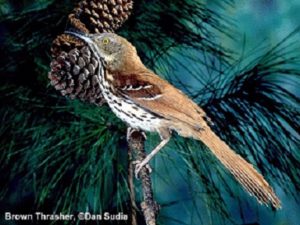(Toxostoma rufum)
 Commonly found in the eastern section of the United States, the Brown Thrasher is the Georgia state bird. It is an elusive bird that prefers brushy edges of woodlands, dry thickets, overgrown fields, shrubby undergrowth in open woods, and residential shrubs and hedges. They are more likely to be heard than seen.
Commonly found in the eastern section of the United States, the Brown Thrasher is the Georgia state bird. It is an elusive bird that prefers brushy edges of woodlands, dry thickets, overgrown fields, shrubby undergrowth in open woods, and residential shrubs and hedges. They are more likely to be heard than seen.
The Brown Thrasher is a large thrasher with bright reddish-brown head and tail. It has a whitish-colored chest with distinguished teardrop-shaped markings. The tail is long and slender and eyes that are a striking yellow. Its bill is brownish, long, and curves downward. Both male and females are similar in appearance. They are often confused with the smaller Wood Thrush.
Brown Thrashers eat insects, invertebrates, small vertebrates, berries, fruits, and nuts They forage for food on the ground in leaf litter below trees and shrubs. These birds sweep the soil and leaf litter with rapid side-to-side movements of their beak. The name Thrasher is thought to come from the thrashing sounds made when they are smashing large insects to eat. Click on image for more info.
The cup-shaped nest is built by both the male and female out of twigs, dead leaves, and other vegetation. The nest is usually built on the ground or near the ground in shrubs or bushes. The female lays 4-5 pale blue and white eggs with brown spots. The eggs have an 11-14 day incubation period. Both parents incubate the eggs and feed the young. The breeding season usually starts in late March and ends in July. Click image at top of page for more info.
Fun Facts:
The Brown Thrasher has been noted for having an aggressive behavior and are staunch defenders of its nest.
They are among the most vocal birds.
The Brown Thrasher is a bird in the family Mimidae, which also includes mockingbirds.
They are said to have the largest repertoire of songs ( 2,000 to 3,000 ) of all North American birds.
Brown Thrashers are mimics, meaning they mimic the calls of other birds. You can thier song from the other mimics (Mockingbird and Gray Catbird) because of the 2 notes. Mockingbirds mimic notes in groups of 3 or more and catbirds mimic single notes at a time.

